Vitamin C And D Foods
Top 10 Foods Highest in Vitamin C

Powered by USDA Nutrition Data
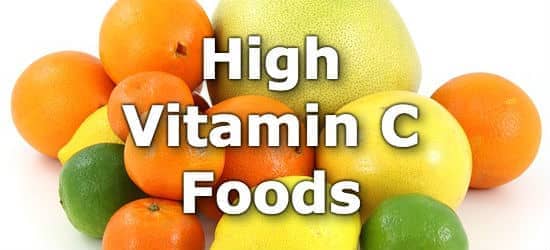
Vitamin C is an essential nutrient required for the maintenance of skin, blood vessels, bones and cartilage, and wound healing. (1,2)
Vitamin C also helps protect cells against oxidative stress, which in turn provides protection against certain diseases, including cancer. (1,3)
Vitamin C, like zinc and vitamin A, also helps support your immune system. (4,5,6)
High vitamin C foods include guavas, bell peppers, kiwifruit, strawberries, oranges, papayas, broccoli, tomatoes, kale, and snow peas. The current daily value (% DV) for vitamin C is 90mg. (7)
Below is a list high vitamin C foods ranked by a common serving size, use the nutrient ranking of over 200 foods high in vitamin C to see the foods highest in vitamin C by nutrient density (per gram), or see rankings of fruits high in vitamin C, and vegetables high in vitamin C.
- Introduction
- High Vitamin C Foods
- Printable
- Vitamin C Foods by Nutrient Density (Vitamin C per Gram)
- Other Vitamin C Rich Foods
- About the Data
- Nutrient Ranking Tool
- Related
- Feedback
- References
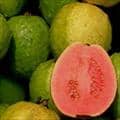
#1: Guavas
| Vitamin C per Cup | Vitamin C per 100g | Vitamin C per 200 Calories |
|---|---|---|
| 377mg (419% DV) | 228mg (254% DV) | 671mg (746% DV) |
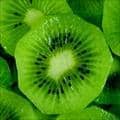
#2: Kiwifruit
| Vitamin C per Cup | Vitamin C per 100g | Vitamin C per 200 Calories |
|---|---|---|
| 167mg (185% DV) | 93mg (103% DV) | 304mg (338% DV) |
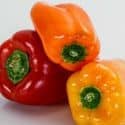
#3: Bell Peppers
| Vitamin C per Cup | Vitamin C per 100g | Vitamin C per 200 Calories |
|---|---|---|
| 152mg (169% DV) | 128mg (142% DV) | 982mg (1091% DV) |

#4: Strawberries
| Vitamin C per Cup | Vitamin C per 100g | Vitamin C per 200 Calories |
|---|---|---|
| 98mg (108% DV) | 59mg (65% DV) | 368mg (408% DV) |

#5: Oranges
| Vitamin C per Cup | Vitamin C per 100g | Vitamin C per 200 Calories |
|---|---|---|
| 96mg (106% DV) | 53mg (59% DV) | 226mg (252% DV) |
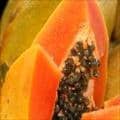
#6: Papaya
| Vitamin C per Cup | Vitamin C per 100g | Vitamin C per 200 Calories |
|---|---|---|
| 88mg (98% DV) | 61mg (68% DV) | 283mg (315% DV) |

#7: Broccoli
| Vitamin C per Cup | Vitamin C per 100g | Vitamin C per 200 Calories |
|---|---|---|
| 81mg (90% DV) | 89mg (99% DV) | 525mg (583% DV) |

#8: Tomato
| Vitamin C per Cup Cooked | Vitamin C per 100g | Vitamin C per 200 Calories |
|---|---|---|
| 55mg (61% DV) | 23mg (25% DV) | 253mg (281% DV) |

#9: Snow Peas
| Vitamin C per Cup | Vitamin C per 100g | Vitamin C per 200 Calories |
|---|---|---|
| 38mg (42% DV) | 60mg (67% DV) | 286mg (317% DV) |

#10: Kale
| Vitamin C per Cup Cooked | Vitamin C per 100g | Vitamin C per 200 Calories |
|---|---|---|
| 23mg (26% DV) | 18mg (20% DV) | 99mg (110% DV) |
See All 200 Foods High in Vitamin C
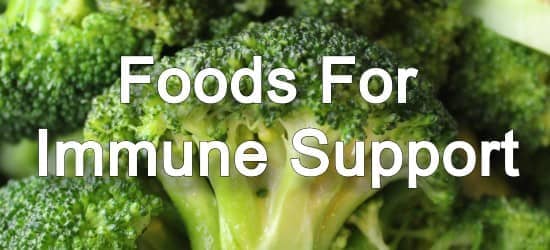 Next ➞
Next ➞
Printable One Page Sheet
Click to Print
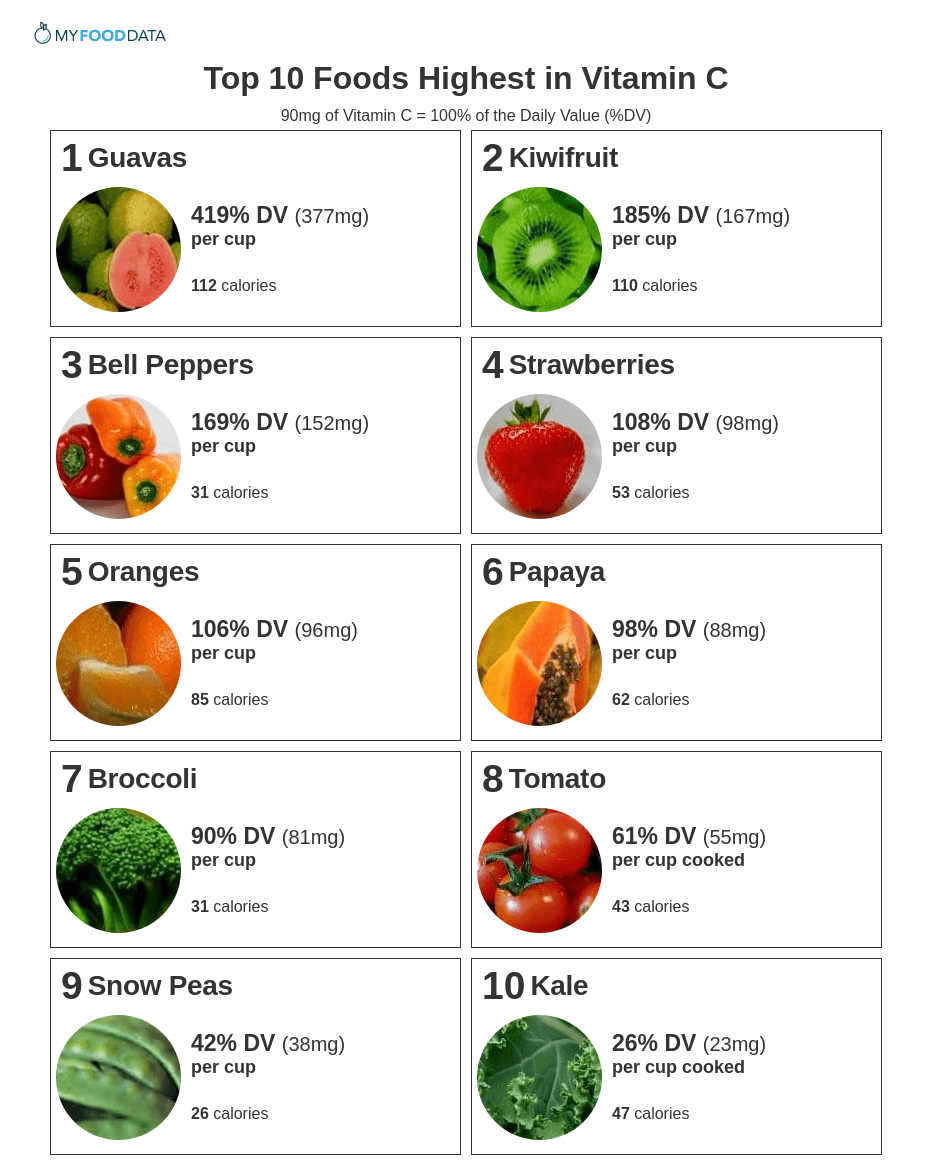
Vitamin C Foods by Nutrient Density (Vitamin C per Gram)
Other Vitamin C Rich Foods
About the Data
Data for the curated food lists comes from the USDA Food Data Central Repository.
You can check our data against the USDA by clicking the (Source) link at the bottom of each food listing.
Note: When checking data please be sure the serving sizes are the same. In the rare case you find any difference, please contact us and we will fix it right away.
- Foods High in Vitamin C
- Foods Low in Vitamin C
- Vegetables High in Vitamin C
- Fruits High in Vitamin C
- Vegetarian Foods High in Vitamin C
- Nuts High in Vitamin C
- Beans High in Vitamin C
- Dairy High in Vitamin C
- Breakfast Cereals High in Vitamin C
- Fast Foods High in Vitamin C
View more food groups with the nutrient ranking tool, or see ratios with the nutrient ratio tool.
- Vitamin E Foods
- Beta Carotene Food Sources
- High Lycopene Foods
- High Iron Foods
- High Potassium Foods
feedback
Data Sources and References
- Mitochondria, Energy and Cancer: The Relationship with Ascorbic Acid. J Orthomol Med. 2010; 25(1): 29–38.
- Office of Dietary Supplements Fact Sheet: Vitamin C
- L-ascorbic acid (vitamin C) induces the apoptosis of B16 murine melanoma cells via a caspase-8-independent pathway. Cancer Immunol Immunother. 2003;52:693–698.
- Vitamin C and Immune Function Nutrients. 2017 Nov; 9(11): 1211.
- The role of vitamin A and related retinoids in immune function. Nutr Rev. 1998 Jan;56(1 Pt 2):S38-48.
- Zinc in Human Health: Effect of Zinc on Immune Cells Mol Med. 2008 May-Jun; 14(5-6): 353–357. Published online 2008 Apr 3. doi: 10.2119/2008-00033.Prasad.
- FDA Daily Values Guidelines
- U.S. Agricultural Research Service Food Data Central
MyFoodData provides nutrition data tools and articles to help you organize and understand the foods you eat. Read more...
Source: https://www.myfooddata.com/articles/vitamin-c-foods.php










